about praque

Prague castle
Prague Castle is the largest medieval castle complex in Europe and is a must for all visitors to Prague. Renovation following several destructive wars and fires, along with differing political forces has combined to create a truly unique architectural complex. The castle has three courtyards and it has always been the seat of Czech rulers as well as the official residence The cathedral\'s foundation stone was laid in 1344 by Emperor Charles IV.
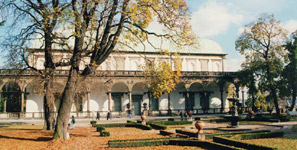
Belvedere
Built in the style of Italian Renaissance, sometime called the most authentic non-Italian renaissance construction, it is a symbol of love between Habsburg Ferdinand I and his wife Anna. It was one of the few happy marriages in the Habsburg dynasty, and this Summer palace, built from 1538 and 1564, was a place where the queen could rest and play games with her girlfriends. After the Saint Vitus Cathedral, this site is the most significant part of the Prague Castle complex. Nowadays it houses temporary modern art exhibitions.
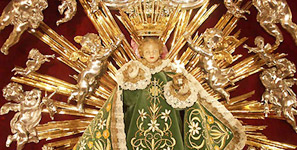
Infant Jesus of Prague
is a famous statue of infant Jesus located in the Church of Our Lady Victorious in Malá Strana, Prague. Its history started in the 17th century when a statue of the Infant Jesus was brought into Bohemia and eventually was given to the Discalced Carmelites in Prague. Since then, the statue has remained in Prague and has drawn many devotees worldwide to go and honor the Holy Child.

St. Nicholas Church
This church was completed in 1735 by Kilian Dientzenhofer; its statues are work of Antonin Braun. Originally a church belonged to a Benedictine Monastery; from 1870 to 1914, the church was used by the Russian orthodox congregation. During the second World War, Czech army units were stationed in the church. During that period, artists, who otherwise would have had to go to the front, were set to work by a colonel to restore the church. After the war, the church was handed over to the Czech Hussite movement. There are beautiful ceiling paintings that show scenes from the life of St Nicholas and St Benedict, and a wonderful chandelier. Classical concerts are held at St. Nicolas throughout the year.
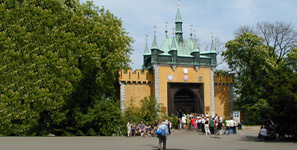
Petřín lookout tower mirror maze
With a height of 318 m the Petřín Hill is a network of eight parks offering magnificent panoramas of Prague. Most of the vineyards from the 12th century were transformed into gardens and orchards by the 18th century and today it is a great place for quiet walks. Up the hill there is the 60m high Observation Tower – an imitation of the Eifel Tower, the Hunger Wall that was built by the poor of the city in return for food in the 14th century, the Mirror Maze, the Church of St Lawrence and the wooden Church of St Michael.
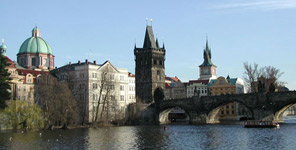
Lesser town bridge tower
The Mala Strana Bridge Tower guards the Mala Strana end of Charles Bridge and marks the main entry point for tourists to this most beautiful area of Prague, a stunning baroque quarter of restaurants, shops, sights and attractions. The Mala Strana Bridge Tower was built in the second half of the 15th century under the rule of King George of Podebrady. Inside the Mala Strana Bridge Tower an exhibition is dedicated to the eventful history of the bridge, with graphic descriptions of the invading armies that have passed along it. You can also climb to the top of the tower to enjoy fine views over Mala Strana, Charles Bridge, the Vltava River and across into Prague\'s Old Town
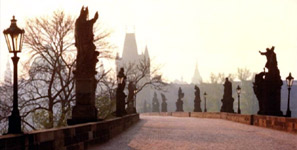
Charles bridge
The oldest Prague bridge built in the place of the Judita\'s Bridge that had been badly damaged by a flood in 1342. In the year1357 Charles IV founded the Stone or Prague Bridge since 1870 called Charles Bridge. The initial idea was to build a functional construction for knight tournaments, and for many years the only decoration on the bridge was a simple crucifix. Later, the Catholic desire for ornamentation resulted in 30 statues being erected between 1600 and 1800. Today, most of the statues are copies, as various floods and catastrophes over the centuries have damaged the originals. There are now 75 statues, and perhaps the most interesting, as well as the oldest, is that of John of Nepomuk.
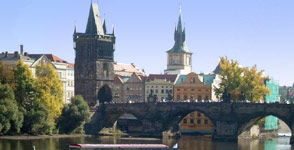
Old town bridge tower
The Old Town Bridge Tower is a wonderful Gothic tower built at one end of Charles Bridge, heralding entrance to the Old Town. This blackened, aged gate tower, completed in 1380, is part of Prague\'s old fortification system, built to help guard the Old Town against northern invaders. Although partially damaged by the failed attempt of marauding Swedes to occupy the Old Town in 1648, sculptures by Peter Parler (whose genius can also be seen in St Vitus Cathedral) survive. Climb the Old Town Bridge Tower for a bird\'s-eye view of Charles Bridge, the Vltava River, the Old Town, Mala Strana and Prague Castle.

Rudolfinum concert hall
The Rudolfinum Concert Hall and Exhibition Centre hosts a varied program of classical music and all kinds of exhibitions. Built between 1876-1884, the Rudolfinum was employed as the state parliament between wars. Today it is used for its original purpose of showing concerts and art exhibitions. The grandeur of both the interior and exterior, and the high standard of the concerts themselves, all make for a very pleasant evening out.
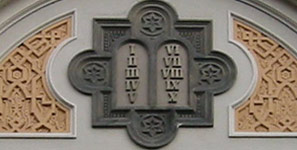
Josefov - Prague Jewish town
Named after the emperor Josef II, the Jewish Quarter contains the remains of Prague\'s former Jewish ghetto. As many of the Jewish died during the WWII and were forced by the communist regime to leave the country, the current Prague community numbers 5000 – 6000 people. There are two figures synonymous with this part of the city, Franz Kafka (1883 – 1924) and the mystical humunculus Golem created by Jehuda ben Bezalel, also known as Rabi Luw.
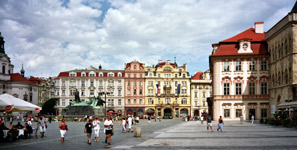
Old Town Square
Being Prague\'s heart since the 10th century and its main market place until the beginning of the 20th century, the spacious Old Town Square has been the scene of great events, both glorious and tragic. There are beautiful pastel-coloured buildings of Romanesque or Gothic origin with fascinating house signs. Today, the Old Town Square offers visitors a tourist information office, number of restaurants, cafes, shops and galleries.
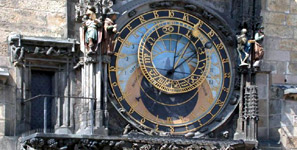
Orloj and Old Town Hall
Old Town\'s ancient town hall was established in 1338 after the agreement of King John of Luxemburg to set up a town council. Several old houses had to be knocked together over the centuries as the Old Town Hall expanded. A Gothic chapel and a neo-Gothic north wing were destroyed by the Nazis in spring 1945. The chapel has been reconstructed. The most popular part of the tower is the Town Hall Astronomical Clock (Orloj).
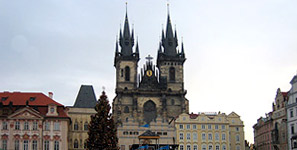
Týn Church
This Gothic church was founded in 1385 during the tumultuous period when the ‘heretic’ Hussites were slaughtered by the ruling Roman Catholics. The Catholic Jesuits then made the church their own by recasting the bell and replacing the Hussites symbolic chalice with the ten-foot figure of Mary nailed up between the towers today. You will notice that the two spires are not symmetrical. This was characteristic of Gothic architecture of the time which tried to represent both the masculine and feminine sides of the world
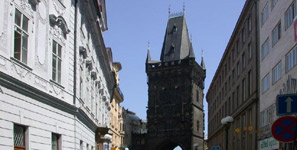
Powder Tower
The 65m-tall Powder Tower was begun in 1475 during the reign of King Vladislav II to form one of the 13 entrances to the Old Town. In 1483 it was left unfinished because the king moved to Prague Castle. Between 1875 and 1886 the tower was rebuilt, decorated and steepled by Josef Mocker. The gate acquired its present name in the 17th century when it was used to store gunpowder. Today, there is a small exhibition about the tower and it is open for great views.
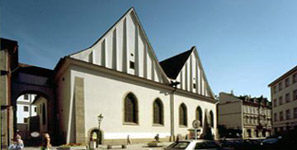
Betlém Chapel
It is a faithful reconstruction of the original 14-th century church in which Jan Hus preached between 1402 and 1413. Handed over to the Jesuits after the Battle of the White Mountain in 1620, the church was completely rebuilt and in 1786 a residential house was built on the side. Following old illustrations the chapel was reconstructed after the WWII.
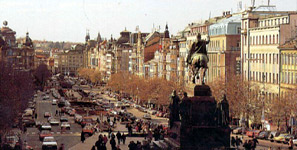
Wenceslas Square
Originally a horse market, it got its present name in the mid-19th century. The Wenceslas Square is the main centre of modern Prague surrounded by shops, cinemas, office blocks, hotels, restaurants and cafes. The 750 m long and 60 m wide square has been the scene of a great deal of Czech history. In the middle of the square there is a monument of St Wenceslas on a horse accompanied with sculptures of four Czech patron saints.
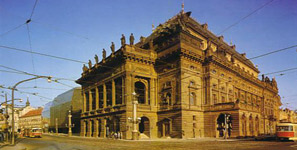
National Theatre
Funded entirely by private donations and created by the most important artists of that era, the Neo-Renaissance National Theatre has always been an important symbol of the Czech cultural revival. Opened in 1881 with the opera “Libuše” by Bedřich Smetana, the architect Josef Zítek\'s masterpiece burned down two months later but it was founded again and restored within two years.

New town hall
A gothic complex of buildings from the late 14th and early 15th centuries, rebuilt in the renaissance style in the 16th century. It contains a tower with Our Lady Chapel, two Gothic halss with ribbed vaults and a renaissance hall. During 1377 - 1784 the seat of the New Town authorities. On 30th July, 1419, the scene of the defenestration of the Catholic aldermen by Prague Hussites which marked the beginning of the Hussite revolution.
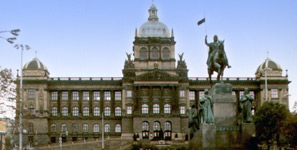
National Museum
Founded in 1818 as a regional natural history museum, the architectural symbol of the Czech National Revival was completed in 1890 in a Neo-Renaissance style. It stands at the upper part of the Wenceslas Square and it is more than 70 m high. Its hall, facade, staircase and ramp are decorated with sculptures made by famous artists. There are changing exhibitions as well as permanent collections devoted to archaeology, anthropology, mineralogy, natural history and numismatics.
